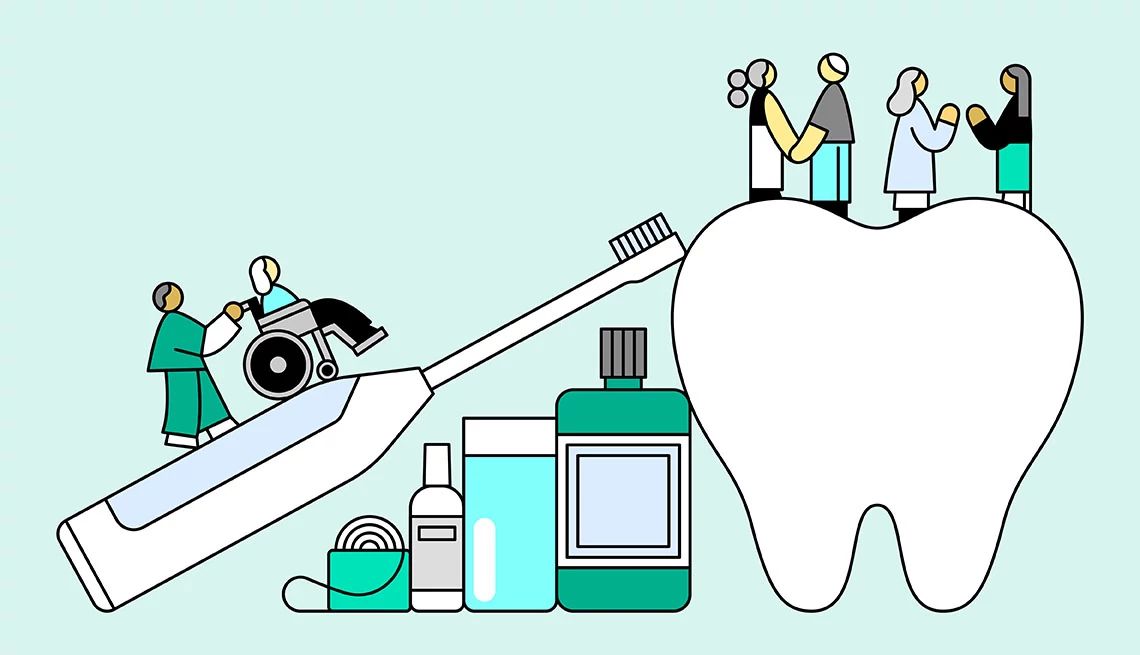AARP Hearing Center


Once meticulous about her personal hygiene, Julie Beaulieu’s mom is now missing several front teeth, and the ones that remain are worn to the gums, decayed and barely usable. Her mom, Irene, 79, who has Alzheimer’s disease and schizophrenia and lives in a nursing home, can no longer chew meat or harder vegetables and has begun to struggle with swallowing.
“As her mental health and cognition have worsened, she’s lost interest in bathing, changing clothes or caring for her teeth,” says Beaulieu, 55, who lives in Holyoke, Massachusetts. “The decline escalated sharply after Mom fractured her neck last summer and spent three and a half months in the hospital, where even the most basic dental care was barely happening.”
The last dentist who saw her mother, three years ago, determined that her teeth weren’t healthy enough to support bridges or implants, which require good bone structure and surgical compliance — almost impossible for someone with cognitive problems. “I’m realistic about the challenges, knowing from other caregivers in the AARP Facebook group about their loved ones not cooperating with dentists and often refusing to wear dentures that frequently get lost.”
For Kathy Landrigan, 69, dealing with oral health is one of many challenges she has faced as a caregiver. Her partner, George, 77, has been bedbound for four years following a severe fall that left him unable to walk. He has since developed cognitive decline alongside physical limitations. George fears dentists, has lingering memories of dental pain and often resists even gentle toothbrushing.
Join Our Fight for Caregivers
Here’s what you can do to support family caregivers:
- Sign up to become part of AARP’s online advocacy network and urge lawmakers to pass legislation to save caregivers time and money.
- Find out more about how we’re fighting for you every day in Congress and across the country.
- AARP is your fierce defender on the issues that matter to people age 50-plus. Become a member or renew your membership today.
Landrigan has turned to hospital-style oral sponges soaked in salt water or mouthwash — gentler than a toothbrush, though less effective. She also relies on mobile dentistry services that bring portable dental equipment into their Bayonne, New Jersey, home for cleanings and fluoride treatments.
“Flossing is unrealistic, and dentures were too painful; I just focus on what George can tolerate,” Landrigan says. “At this stage, I’ve learned that perfect is the enemy of good. Keeping him comfortable matters more than stressing him out with perfect dental care.”
When growing older means greater dental risk
While rates of total tooth loss have declined over the past several decades, 17.3 percent of adults 65 and older still have no remaining teeth, according to the National Institutes of Health. There’s a critical gap in dental insurance coverage that leaves many older adults vulnerable to higher rates of oral health problems. An estimated 31 million adults 55 and older lack dental insurance, according to the National Association of Dental Plans Foundation.


































































More From AARP
Seeing the Full Picture of Macular Degeneration
Caregivers serve as the ‘eyes’ for people with macular degeneration
Caring for Someone With Osteoporosis
You can help prevent falls and life-changing fractures
How to Help Parents Navigate Big Life Changes
Learn ways to support older adults when it is time to move on